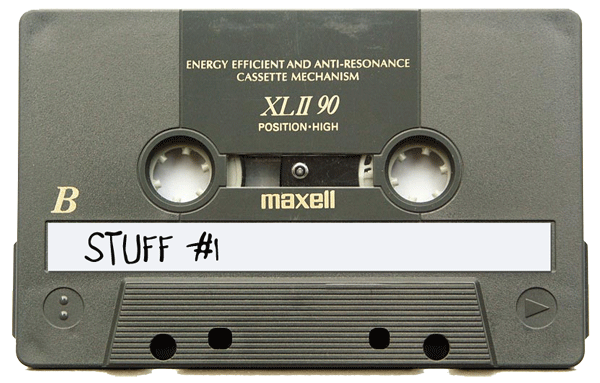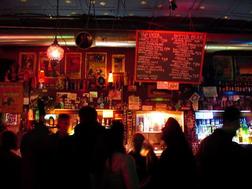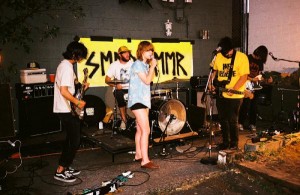In their ten-year-long effort to purge “the shrine” aka my old high school bedroom, my parents occasionally drop off boxes of my old “stuff.” So far I’ve received boxes of baseball cards (one of dozens), books, magazines, Super Nintendo and Genesis games, CDs, Transformers and now cassette tapes — a big ole shoebox full of cassette tapes, almost all of which are dubs. Plenty of the cassettes are completely free of label. So it might take me some time to go through them all. But I’ve found three labeled tapes, three labeled mixtapes, in the lot. I’ve created Spotify playlists for each. I’ve not “bettered” the mixes in any way. The awful tracks remain, blemishes on my taste (and lack thereof) as a teenager. What you see here is the track order as they were created from 1993-1996. Enjoy these time capsules (or not), these (ugh) plastic windows into my teenage schizophrenia.
The Mixtape Project: Volume 2, Stuff #1
Unless my mixtapes were thematic I always called them “Stuff” and then numbered them sequentially. I spent more creative juices coming up with titles for the thematic mixes (e.g. Caffeine) so I should get a bye for not wasting energy with these titles. Out of all ten or so “Stuff” tapes, only #1 survives. Or at least, it’s the only one that still has a label. I may find more as I go through all of the unlabeled tapes in this box. A handful were lost when someone stole my car in college. So it goes.
Stuff #1 (a mixtape from Sept. of 1995) on Spotify.
Side A:
“Big Sky” – Reverend Horton Heat
If I could have opened every mixtape with “Big Sky” I would have. Reverend’s Rockabilly burner brings all of my favorite mixtape-opener elements: 1) instrumental; 2) 3 minutes or less; 3) also opens a favorite album (1994’s Liquor in the Front).
“Another Day” – Dream Theater
After a burner, I always liked to drop the pace. So far I’m going paint-by-numbers with “Stuff #1.” Reverend. Check. Dream Theater. Check. Prog melodrama (featuring a killer sax solo/outro) may have been a jarring switchback after Reverend, but considering I listened to an EPIC CRAP-TON of Reverend and Dream Theater during these years, I’ll allow it.
“Pain Lies On the Riverside” – Live
Jackin’ the pace back up. If you’re a Live auto-hater and you auto-hate “Pain Lies On the Riverside,” FOR FLIPPING SHAME. Live might have eventually sucked donkey balls, but Mental Jewelry was a great rock album and this was a legitimate jam.
“Dela” – Johnny Clegg & Savuka
The first monkey wrench. Some people went through their Afro-pop phase with Paul Simon, but Johnny Clegg and I cruised that savannah with the top down and the Cruel, Crazy, Beautiful World album on repeat. I recently learned that this song played a prominent role in the movie George of the Jungle. I have no comment. Don’t ask me again. I don’t know anything.
“Don’t You (Forget About Me)” – Simple Minds
Staying in the 80’s, I maintained mid-tempo with a low-hanging Simple Minds track. At this point, I’d stumbled into the Simple Minds backwards through their underappreciated 1995 record Good News from the Next World and then Glittering Prize, their 1992 greatest hits collection. I’d retrospect this one into “Up on the Catwalk” or “All the Things She Said,” but, like I said, they were new to me at the time… and thus this song wasn’t yet burnt out.
“Pass the Hatchet” – Roger & the Gypsies
Does anyone still listen to the Desperado soundtrack? Man, what a record. And such a slice of my 1995 moment. I was smitten with the movie and Salma Hayek, the soundtrack and, well, Salma Hayek. (I was 17 when this movie came out.) I loved throwing these curveballs onto different “Stuff” records because songs like this introduced a style of music I’d not yet discovered. This song and the Get Shorty soundtrack opened a gateway to the Stax instrumental funk/soul sound of the 70’s.
“Sister Havana” – Urge Overkill
When I think over forgotten gems of the 90’s I think of “Pain Lies On the Riverside” and “Sister Havana.” Prior to Saturation, Urge Overkill released three relatively meh records and after Saturation, they released another couple of records to which nobody listened (they were actually pretty good, including 2011’s terribly named Rock & Roll Submarine). But for a fleeting moment in 1993-94, UO killed it, which is really better than not killing it at all. In the end, they’ll just be remembered for playing the Neil Diamond cover “Girl, You’ll Be a Woman Soon” on the Pulp Fiction soundtrack. Is that fame? Fame by association perhaps. Maybe they could make a comeback by doing a “Cracklin’ Rosy” cover.
“Cancion del Mariachi” – Antonio Banderas & Los Lobos
Two points to mention here. 1.) See all that was said about obsessing over Desperado above. 2.) 2:00 filler. But, you know what? No apologies. It’s a damn fine song. Whatever it is.
Side B:
“Jessica” – Allman Brothers Band
I think I said something earlier about opening mixtapes with instrumentals, no? I took it one step further. I opened Side B with a instrumental too. This must be the best mixtape ever. Now I own this record on vinyl and it still gets plenty of airplay. My daughter doesn’t quite know what to make of it though. Hell, I originally owned Brothers and Sisters on one of those pimped-out gold Original Master Recording CDs.

“I Know Why The Caged Bird Sings” – Buckshot LeFonque
This is Branford’s acid-jazz collective / collaboration with hip-hop producer extraordinaire DJ Premier. This self-titled record served as my gateway to Herbie Hancock, Miles Davis, et al. I’m not sure the entire record aged as well as this track, for which Branford and co. built music around a recording of Maya Angelou reciting her poem of the same name. It’s a remarkable cut that works as an individual piece of jazz/fusion and as a aural worship of Maya Angelou. I, of course, cannot help myself and follow this with…
“Holler If Ya Hear Me” – 2Pac
I loved me some sonic mixtape whiplash. The best 2Pac song from the best 2Pac album. The albums released after this, including all of those released after his untimely death, catered to a broader audience and really lost track of the raw production and lyricism that populated his first two records. Don’t tell me you “just loooooove 2Pac” if you don’t looooooove Strictly 4 My N.I.G.G.A.Z.
“Low Rider (En Espanol)” – War
I must have thought I was being innovative, tracking down a version of “Low Rider” en Espanol. 2012 me isn’t all that impressed with my musical fascination with “Low Rider” in any language. I am impressed with my ingenuity, however, since I don’t even know where I even found this track.
“Mama Take” – Chicago
So I liked Chicago quite a bit. Even all the later schmaltzy stuff that makes some people think of Air Supply. “Mama Take” comes from their twelfth studio album, 1979’s XIII, otherwise known as intersection of critical and commercial distaste. I will not admit to seeing them four times in concert. The disco-era had begun to seep into the band’s jazzy sound on this record. Thus, hate. It’s not that really that bad (IF you like Chicago). If there’s a moment, however, when “Stuff #1” leaves the reservation it’s the transition into Chicago from (Latin) War and then into…
“As I Lay Me Down” – Sophie B. Hawkins
I guess I needed one of those pop songs that you’ll always remember even if you forget the name of the artist that recorded it. Must have been my token female artist for the mixtape. If you don’t take yourself too seriously, this is still a good song. If you hate 90’s pop nostalgia, and/or fun, you’re going to rage on this choice. By the way if you want to witness the person most tired of this song, watch Sophie B. perform this song in 2011. The recording method doesn’t help, but damn. I bet she’d rather be doing a Neil Diamond cover too.
[tube]http://www.youtube.com/watch?v=8QQNs_af_eU[/tube]
“Bales of Cocaine” – Reverend Horton Heat
Well, I was workin’ on my farm ’bout 1982,
Pullin’ up some corn and a little carrot, too
When two low-flying aeroplanes, ’bout a hundred feet high
Dropped a bunch o’ bales o’ somethin’, some hit me in the eye…
So I cut a bale open, an’ man was I surprised
Bunch o’ large sized baggies, with big white rocks inside
So I took a little sample to my crazy brother Joe
He sniffed it up and kicked his heels, said, ‘Horton, that’s some blow!’
“Recipe for Love” – Harry Connick, Jr.
I dunno. Just… I dunno.
Bombay Vindaloo – Dream Theater
The Good: Dream Theater never recorded this track in the studio and it only appeared on the Live at the Marquee album. So it’s got some rare-track fan cred and serves as a great closing track to the mix. Slow build, another instrumental…
The Bad: 2nd Dream Theater track on the record. After the Harry Connick, Jr. song followed by a 2nd Dream Theater I clearly ran out of ideas and just started phoning this one in. I’d have rather dropped “Another Day” from Side A and left this one right where it is.
[tube]http://www.youtube.com/watch?v=gJtj2OELH6A[/tube]
Overall Rating:
Unlike “Caffeine” this one at least makes a lot of mixtape sense… until the end. Without docking points for the Desperado rehash (filler clemency), it’s a damn good mix of the moment. September 1995. I can’t fault too many of the song choices. I’ve noted my beefs. The moment begins to wear thin by the time the mix hits “Low Rider.” Meh. But bonus points for being a curio, I suppose.
As a dynamic mixtape that borrowed the rules of mixtaping, the rise and fall is strong. I never held too closely to single style and quarantined the oddities to the B-Side, where they generally belong. Side B might be a little too retro with the Allman Brothers, War and Chicago… and I needed to refrain from doubles. It’s a stylistic concern that should have been addressed. No doubt. I would have thrown another hip-hop song on the Side A for balance and slotted in some more contemporary rock that wasn’t another Reverend double up. Dispense with the doubles. Pfft. Lazy teenager.
7/10




